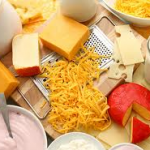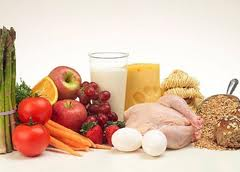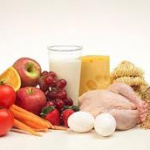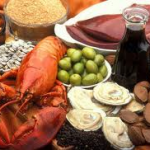Are there certain kinds of food that can cut down the hot flashes?
With diet and hot flashes it’s a bit of trial and error. Something may work for some women, so either you have to throw them all up in the air and see what helps you.
- Avoiding spicy foods around your prime hot-flash time can help.
- Eating smaller-sized meals, because large meals can increase your body temperature.
- Chewing on ice chips or sipping on some ice-cold, no-calorie beverages at a time when you tend to have hot flashes can help decrease your body temperature.
- If it’s convenient, taking a colder shower before you tend to get hot flashes, or swimming, if that’s practical, actually decreases your body temperature for hours afterwards.
- Try a daily serving or two of a phytoestrogen-rich food, like soymilk, tofu, or edamame.
- You could try some other phytoestrogen rich foods, like papaya, peas, and beans.
- Then there’s ground flax seed. Flax seed is the most potent food source of the phytoestrogen called lignin. You need it to be ground and a general sort of amount is 1 tablespoon a day.
Now, the foods to lose for hot flashes would be the hot and spicy type foods, foods with caffeine as beverages, and alcohol.
Are there any foods you should avoid; foods that make the hot flashes and night sweats and bad moods worse?
This could be a book in and of itself. It’s a very complicated and interesting tie-in between what we eat and our moods. We’re basically going to try to eat foods that give us nutrients that elevate our mood. Let me just kind of throw some at you.
- Working some omega-3 fatty acids from fish and plant sources may be one of the most important ways to decrease depression and elevate mood. It’s sort of a mood stabilizer. We’re only now learning the extent of the relationship between omega-3s and mood.
- You want to eat a balanced breakfast . Start your day off without starving. A nice balanced breakfast that has some good fats and some lean and low-fat proteins will last longer and keep your blood sugar more even through the morning.
- Then we get into sort of “happy foods,” or foods that boost serotonin levels in the brain. Believe it or not, this leads us mainly to eating carbohydrates . Perhaps that’s why so many comfort foods include some carbohydrates in them. My suggestion is to definitely opt for the smarter carbs when possible, meaning whole grains. Pasta is actually fine in terms of glycemic index as long as it’s cooked al dente. Slightly undercooking it makes the body have a harder time breaking it down, which translates into a lower glucose response. Obviously enjoy your pasta with light and healthy pasta sauce.
- Then there’s folic acid , a very, very powerful vitamin with antioxidant types of activity. You basically get your folic acid in foliage: fruits and vegetables.
- Avoiding alcohol is a great idea. People think that drinking alcohol elevates their mood, but it’s short-lived, and if you overdo it, it does the opposite.
- Selenium is a mineral that the brain depends on. We’re trying to elevate our mood, so we’re dealing with brain chemistry here. A few selenium rich foods are:
- Brazil nuts
- Oysters
- Albacore tuna
- Clams
- Sardines
- Pork tenderloin
- All salt-water fish
- Whole-wheat pasta
- Chicken
- Whole-grain breads
- Sunflower seeds
- Brown rice, oatmeal
- Tofu
- Pinto beans
Gaining weight seems to be unavoidable during menopause. What’s the best thing we can do for ourselves to prevent that dreaded “middle-age spread?”
You don’t have to roll over and play dead here. You can fight this by exercising more and doing some strength training for your muscles. This will increase your metabolic rate. You’re trying to increase your metabolic rate to counteract the natural decrease that’s coming with aging, thereby sort of neutralizing this.
Also, eating smaller meals through the day and eating light at night will help sort of increase your metabolism. Paying more attention to portion size is key here, because some of the women who have not had to pay attention to portion sizes earlier in life (definitely not me) now have to because of the shift, because of the changes. Now is the time to pay attention to eating when you’re hungry and stopping when you’re comfortable. Many people get away from this. It sounds simple, but it’s something we have to re-learn.
Another key is not to diet. No “fad diets,” because dieting sort of starts messing around with the eating when you’re hungry, stopping when you’re comfortable strategy, and I think we all know in our heart of hearts that diets don’t work long term. What do make a difference are the permanent changes we make in our food choices and our lifestyle.
 Let me just list a few secret weapons I talk about in my book to put the odds in your favor about weight loss and weight maintenance:
Let me just list a few secret weapons I talk about in my book to put the odds in your favor about weight loss and weight maintenance:
- Secret weapon No. 1: Low-fat, nonfat dairy products . There’s something about calcium that seems to help your body lose weight or keep weight off. It falls right in line with getting more calcium as we age. So making a point of having a couple servings a day makes a lot of sense.
- Secret weapon No. 2: A serving of soy . It looks like soy may mimic many of the weight loss benefits from calcium and dairy. Again, this falls right in line with what we should be doing with some of the other symptoms.
- Secret weapon No. 3: Don’t forget the fiber . We simply don’t get enough, and it’s an important filler in our meals. It helps give us a feeling of fullness, generally without a lot of calories. It also helps moderate the possible rise in blood glucose when we eat carbohydrates.


